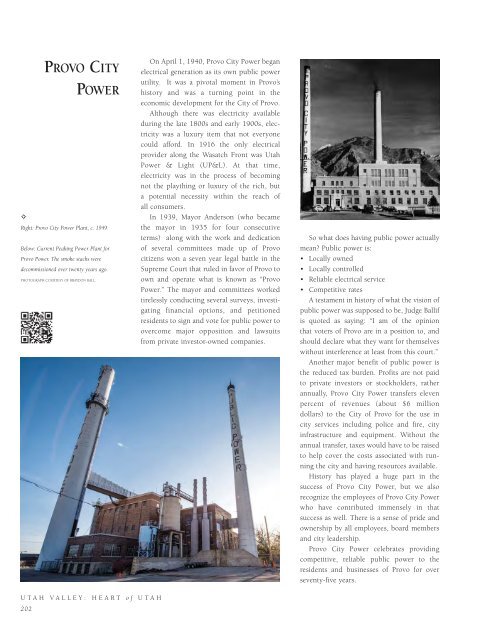Utah Valley: Heart of Utah
A full-color photography book showcasing Utah Valley, paired with the histories of companies, institutions, and organizations that have made the region great.
A full-color photography book showcasing Utah Valley, paired with the histories of companies, institutions, and organizations that have made the region great.
Create successful ePaper yourself
Turn your PDF publications into a flip-book with our unique Google optimized e-Paper software.
PROVO CITY<br />
POWER<br />
✧<br />
Right: Provo City Power Plant, c. 1949.<br />
Below: Current Peaking Power Plant for<br />
Provo Power. The smoke stacks were<br />
decommissioned over twenty years ago.<br />
PHOTOGRAPH COURTESY OF BRAYDON BALL.<br />
UTAH VALLEY: HEART<br />
202<br />
On April 1, 1940, Provo City Power began<br />
electrical generation as its own public power<br />
utility. It was a pivotal moment in Provo’s<br />
history and was a turning point in the<br />
economic development for the City <strong>of</strong> Provo.<br />
Although there was electricity available<br />
during the late 1800s and early 1900s, electricity<br />
was a luxury item that not everyone<br />
could afford. In 1916 the only electrical<br />
provider along the Wasatch Front was <strong>Utah</strong><br />
Power & Light (UP&L). At that time,<br />
electricity was in the process <strong>of</strong> becoming<br />
not the plaything or luxury <strong>of</strong> the rich, but<br />
a potential necessity within the reach <strong>of</strong><br />
all consumers.<br />
In 1939, Mayor Anderson (who became<br />
the mayor in 1935 for four consecutive<br />
terms) along with the work and dedication<br />
<strong>of</strong> several committees made up <strong>of</strong> Provo<br />
citizens won a seven year legal battle in the<br />
Supreme Court that ruled in favor <strong>of</strong> Provo to<br />
own and operate what is known as “Provo<br />
Power.” The mayor and committees worked<br />
tirelessly conducting several surveys, investigating<br />
financial options, and petitioned<br />
residents to sign and vote for public power to<br />
overcome major opposition and lawsuits<br />
from private investor-owned companies.<br />
<strong>of</strong> UTAH<br />
So what does having public power actually<br />
mean? Public power is:<br />
• Locally owned<br />
• Locally controlled<br />
• Reliable electrical service<br />
• Competitive rates<br />
A testament in history <strong>of</strong> what the vision <strong>of</strong><br />
public power was supposed to be, Judge Ballif<br />
is quoted as saying: “I am <strong>of</strong> the opinion<br />
that voters <strong>of</strong> Provo are in a position to, and<br />
should declare what they want for themselves<br />
without interference at least from this court.”<br />
Another major benefit <strong>of</strong> public power is<br />
the reduced tax burden. Pr<strong>of</strong>its are not paid<br />
to private investors or stockholders, rather<br />
annually, Provo City Power transfers eleven<br />
percent <strong>of</strong> revenues (about $6 million<br />
dollars) to the City <strong>of</strong> Provo for the use in<br />
city services including police and fire, city<br />
infrastructure and equipment. Without the<br />
annual transfer, taxes would have to be raised<br />
to help cover the costs associated with running<br />
the city and having resources available.<br />
History has played a huge part in the<br />
success <strong>of</strong> Provo City Power, but we also<br />
recognize the employees <strong>of</strong> Provo City Power<br />
who have contributed immensely in that<br />
success as well. There is a sense <strong>of</strong> pride and<br />
ownership by all employees, board members<br />
and city leadership.<br />
Provo City Power celebrates providing<br />
competitive, reliable public power to the<br />
residents and businesses <strong>of</strong> Provo for over<br />
seventy-five years.
















